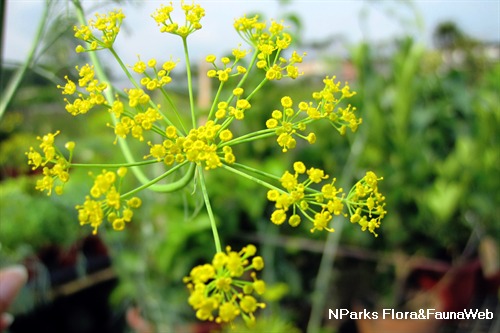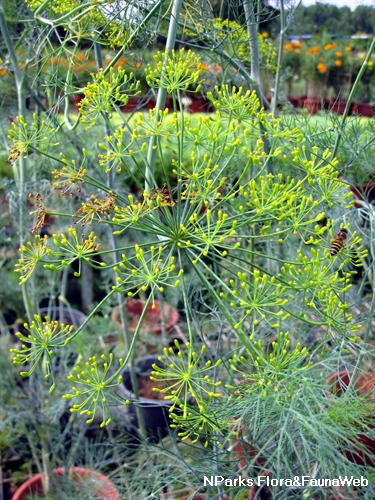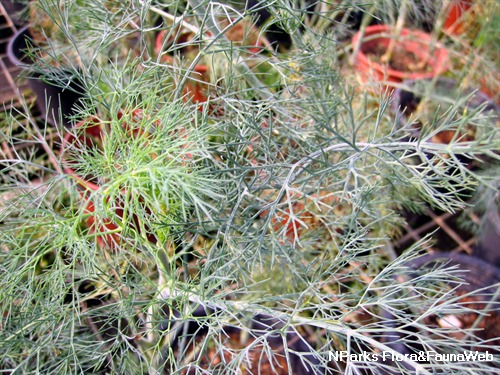
Name
Classifications and Characteristics
| Plant Division | Angiosperms (Flowering Seed Plants) |
|---|---|
| Plant Growth Form | Herbaceous Plant |
| Lifespan (in Singapore) | Annual |
| Mode of Nutrition | Autotrophic |
| Maximum Height | 0.9 m to 1.5 m |
| Maximum Plant Spread / Crown Width | 0.6 m to 0.9 m |
Biogeography
| Native Distribution | Asia Minor, Mediterranean |
|---|---|
| Native Habitat | Terrestrial |
| Local Conservation Status | Non-native (Horticultural / Cultivated Only) |
Description and Ethnobotany
| Growth Form | Annual herb up to 1.5 m tall. |
|---|---|
| Foliage | Blue-green, feathery leaves are finely divided into soft, needle-like segments. |
| Flowers | Yellow flowers are arranged in a compound umbel. |
| Cultivation | To prevent the long, hollow stems from falling over, space them closely together at about 15 cm apart and protect them from strong wind. Plants will be more sturdy in full sun compared to semi-shade. This deep-rooted species can be planted in a large container. It grows best in consistently moist soil that is well-drained. |
| Ethnobotanical Uses | Edible Plant Parts : Edible Leaves, Edible Seeds Food (Herb or Spice): The leaves are used to flavour a variety of dishes (eg., fish, spinach and potatoes) and creamy sauces, like sour cream and yogurt-based sauces. |
Landscaping Features
| Desirable Plant Features | Ornamental Flowers, Ornamental Foliage, Fragrant (Foliage) |
|---|---|
| Landscape Uses | Flowerbed / Border, Container Planting |
| Thematic Landscaping | Economic Garden |
Plant Care and Propagation
| Light Preference | Full Sun |
|---|---|
| Water Preference | Lots of Water |
| Rootzone Tolerance | Moist Soils, Well-Drained Soils, Easy to Grow |
| Propagation Method | Seed |
Floral (Angiosperm)
| Flower & Plant Sexuality | Bisexual Flowers |
| Flower Colour(s) | Yellow / Golden |
|---|---|
| Flower Grouping | Cluster / Inflorescence |
| Flower Location | Terminal |
| Flower Symmetry | Radial |
| Inflorescence Type | Compound Umbel |
Image Repository
Others
| Master ID | 31998 |
|---|---|
| Species ID | 6400 |
| Flora Disclaimer | The information in this website has been compiled from reliable sources, such as reference works on medicinal plants. It is not a substitute for medical advice or treatment and NParks does not purport to provide any medical advice. Readers should always consult his/her physician before using or consuming a plant for medicinal purposes. |



